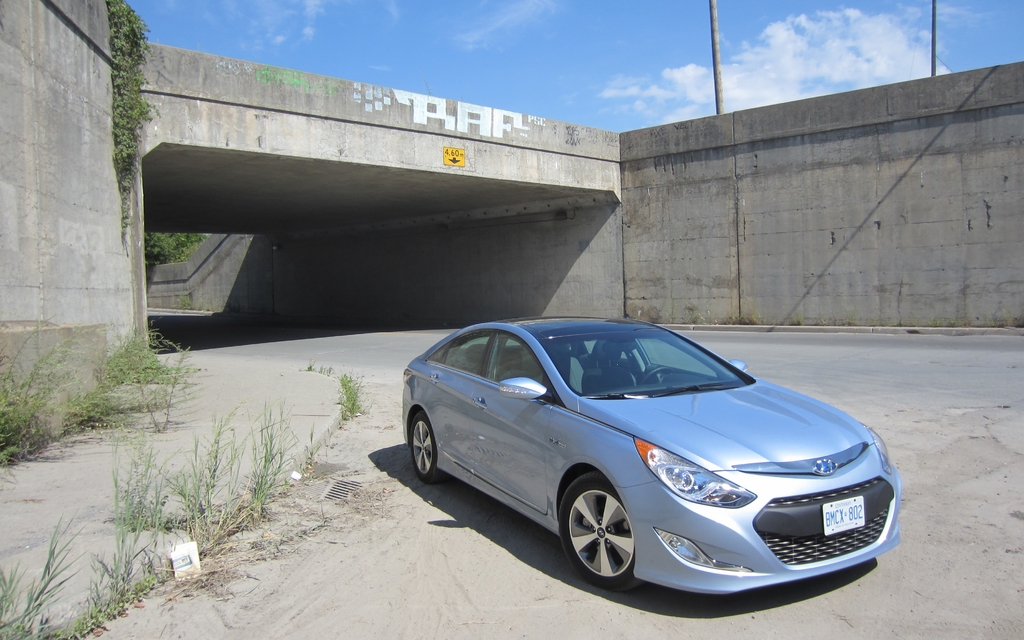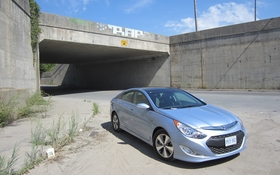2012 Hyundai Sonata Hybrid - Almost, But Not Quite

| Strong points |
|
|---|---|
| Weak points |
|
Hybrid family cars are not quite as common as one would think, with only a few different manufacturers offering gasoline / electric editions of their mid-size sedans outside of the luxury segment. The 2012 Hyundai Sonata Hybrid is one of these rare beasts, a vehicle that attempts to combine value, fuel efficiency, and style in a single package. Hyundai's renaissance as one of the most popular brands in Canada, combined with its thirst to deliver products in every conceivable niche, means that a battery-powered Sonata was inevitable.
Don't expect the Sonata Hybrid to simple be a clone of the standard Sonata, however, as the brand has made several changes to the platform in order to court eco-conscious customers. Do these alterations to what was previously a winning formula help or hinder the Sonata Hybrid's quest for market share? The answer isn't exactly a straightforward one.
Messing With Success
The recently redesigned Hyundai Sonata has been almost universally praised for its sculpted good looks, a design that erases years of forgettable sheet metal from the brand's family sedan. For reasons that are partly related to aerodynamics, and partly due to the fact that Hyundai felt the need to provide Hybrid buyers with an extra incentive to choose that particular model, the 2012 Hyundai Sonata Hybrid offers a substantially revised appearance when compared to its sibling. A gaping maw of a grille now sits up front, with the Hyundai badge sitting in the middle of a long chrome strip that is found at the base of the hood. A drab piece of black plastic cuts the blacked-out grille in half. The overall effect of these changes unfortunately gives the Sonata Hybrid a low-rent look compared to the more attractive gasoline model, despite the grafting of new jeweled tail lights to the automobile's rear.
Inside, Hyundai has left well enough alone, maintaining essentially the same look and feel found inside the non-hybrid. Despite a few ergonomic miss-steps on the materials front in the form of hard plastics where one would expect softer-touch materials, this is a good thing. The Hyundai Sonata Hybrid's leather seats were comfortable, and there was plenty of room for passengers both front and rear (although the trunk loses a fair amount of room due to the needs of the vehicle's battery pack).
Using the Sonata Hybrid's voice command system returned mixed results, with both the navigation and hands-free phone feature balking at several seemingly standard address and contact list commands. That being said, the attractive LCD screen sitting at the top of the center stack did offer an amusing, if somewhat puzzling graphic of a spinning globe with power flowing both too and from it depending on how the Hybrid was being driven. A few other screens were also available to track the efficiency and green quotient of the sedan, including a measurement of the automobile's fuel economy as displayed at two minute intervals via a bar graph - a function that frustratingly was shown in 'miles per gallon' with no ability to change to kilometers or liters.
Unrefined Driving Experience
The greatest knock against the 2012 Hyundai Sonata Hybrid isn't its styling - it's the way it drives. The vehicle features a 206 horsepower hybrid system that also produces 193 lb-ft of torque, and it's made up of a 2.4-liter, four-cylinder gas motor combined with a battery-powered electric unit. The latter is stuffed inside the sedan's six-speed automatic transmission, which reduces complexity and improves packaging.
When pulling away from a stop (or coasting), the Hyundai Sonata Hybrid does its best to keep the vehicle in EV (electric-only) mode for as long as possible, which is an admirable trait that can see drivers traveling much farther than one would have thought possible on battery power alone. The lack of refinement starts to show through once the vehicle decides that it's time to add the gas engine to the mix, kicking it in abruptly and somewhat unpredictably. What's more, the vehicle's regenerative brakes suffer from the same 'on / off' feeling, which makes it difficult to modulate stopping power - not to mention the fact that the binders don't offer the same level of competency as those found on the gas sedan. Throw in suspension tuning that allows the car to wallow when pushed hard or feel loose when dealing with Montreal's admittedly unkempt roads, and the Hyundai Sonata Hybrid simply comes across as a notch or two lower than competitors like the Ford Fusion Hybrid and the Toyota Camry Hybrid in terms of providing a smooth and transparent driving experience.
Fuel mileage wasn't up to expectations either. Hyundai Canada posts a rating of 4.6 L/100 km in city driving and 5.1 L/100 km on the highway. The Sonata Hybrid struggled to beat 7 L / 100 km during its time in our garage.
First, But Not Best Effort
From a value perspective, the current generation of the 2012 Hyundai Sonata Hybrid is a mixed bag. For those shopping for a mid-size, battery-assisted sedan, its base MSRP of $30,679 compares favorably with the previously-mentioned Fusion Hybrid but comes in much higher than the Toyota Camry Hybrid's starting MSRP of $26,990. Even the well-equipped Camry Hybrid XLE undercuts the Sonata Hybrid's pricing. There is also the fact that the Fusion Hybrid is about to be offered in an all-new design that will certainly draw more than its fair share of attention throughout the first half of 2013. The Hyundai Sonata Hybrid is already not quite up to par with the current round of contenders, which makes it clear that a number of tweaks are necessary to keep it up to date in the face of the next-generation of hybrid family cars.











